Click on images to enlarge
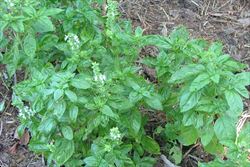
habit (Photo: Sheldon Navie)
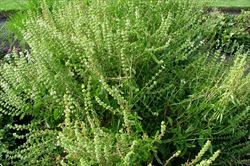
habit in fruit (Photo: Sheldon Navie)

leaves (Photo: Sheldon Navie)
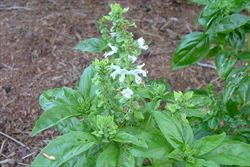
flower cluster (Photo: Sheldon Navie)
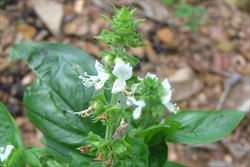
close-up of flowers (Photo: Sheldon Navie)
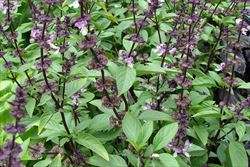
Thai basil, Ocimum basilicum var. thyrsiflora (Photo: Forest and Kim Starr, USGS)
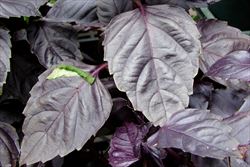
purple basil, Ocimum basilicum var. purpureum (Photo: Forest and Kim Starr, USGS)
Scientific Name
Ocimum basilicum L.
Family
Labiatae (South Australia)Lamiaceae (Queensland, New South Wales, the ACT, Victoria, Tasmania, Western Australia and the Northern Territory)
Common Names
basil, common basil, garden basil, sweet basil
Origin
This species has been widely cultivated for thousands of years, and hence its exact origin is obscure. It is possibly native to tropical Africa and western Asia (i.e. maybe north-eastern India and Iran).
Naturalised Distribution
Sweet basil (Ocimum basilicum) has become naturalised in some parts of northern Australia (i.e. in northern and central Queensland and in the Kimberley region in northern Western Australia). It has also been recorded as naturalised near Perth in south-western Western Australia and sparingly naturalised in some parts of South Australia.
Also naturalised overseas in many parts of the USA and on numerous Pacific islands (e.g. Fiji, French Polynesia, Guam, Kiribati, New Caledonia, the Solomon Islands and Hawaii).
Notes
Sweet basil (Ocimum basilicum) is regarded as an environmental weed in Western Australia and Queensland. This species is very commonly cultivated in gardens as a culinary herb, and numerous cultivars and varieties are available. However, it has escaped cultivation, particularly in the tropical and semi-arid regions of northern Australia. It is most commonly found growing in disturbed sites and waste areas, along roadsides and in drains, but also invades disturbed natural vegetation, open woodlands and riparian areas.
In Western Australia, sweet basil (Ocimum basilicum) is mainly of concern in the northern parts of the state (e.g. near Broome and on Kimberley Downs Station), and is listed as a minor environmental weed in the state's environmental weed strategy. It has also become an environmental weed in the desert uplands bioregion in inland central Queensland. For example, it is a common weed of the ground layer in gidgee woodlands on the floodplain of Dyllingo Creek near Clermont.

